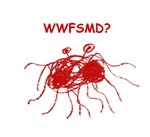Is America facing yet another dust bowl?
For example: Is America facing yet another dust bowl?
Accu-Weather.com meteorologists have warned oceanic conditions similar to those that triggered the ruinous "Dust Bowl" drought again appear to be in place.
The exceptionally warm Atlantic waters that played a major role in the record-breaking 2005 hurricane season, coupled with cooler-than-normal Pacific waters, are weakening and changing the course of a low-level jet stream that normally channels moisture into the Great Plains. Effects are starting to be felt in "America's breadbasket," as the southern Great Plains region is already suffering from higher temperatures and a prolonged lack of precipitation.
Why could a new Dust Bowl drought occur? The low-level jet stream — a fast-moving current of winds close to the Earth's surface — travels from east to west across the Atlantic, then typically curves northward as it crosses the Gulf of Mexico, bringing moisture to the Great Plains. Abnormal sea-surface temperatures have caused this low-level jet stream to continue westward and to weaken, which is preventing much-needed moisture from reaching the agriculturally critical region. The shift in the jet stream is also allowing a southerly flow from Mexico to bring much drier air northward into the Plains. Besides dramatically reducing precipitation for the region, the changes brought about by the abnormal sea-surface temperatures will also result in higher surface temperatures in the Plains.
"When surfaces are wet, energy from solar radiation both evaporates moisture and heats the ground," said AccuWeather.com Chief Meteorologist Elliot Abrams. "When no moisture is present, all that energy is channeled toward heating the ground, and the warm-er ground heats the lower atmosphere. “The combination of low moisture and higher temperatures would be a crippling one-two punch for the Great Plains should these conditions persist, much like what occurred during the Dust Bowl drought."
The Dust Bowl, which lasted from 1931-1939, was a severe drought that struck a wide swath of the Great Plains. It was a catastrophic blow to the U.S. economy, which was already staggering under the weight of the Great Depression.
The Dust Bowl was the worst drought in U.S. history, eventually covering more than 75 percent of the country. Solar radiation heating the parch-ed and blighted land caused temperatures in the region to rise to record-breaking levels. "1936 was the hottest summer ever recorded across much of the Midwest and East," said Abrams. "Many of the single-day and monthly record-high temperatures across the eastern two-thirds of the country are from that year."
The Dust Bowl was also noted for the huge dust storms that billowed across the Great Plains and swallowed millions of acres of farmland at a time. While a Dust Bowl-level drought could occur again, it is highly unlikely that the nation will see a return of the dust storms. "The dust storms fed off the over-plowed and over-grazed lands of the Great Plains," said Dale Mohler, AccuWeather.com expert senior meteorologist and a forecaster for the agricultural industry.
Many of us already figured the oceans would rise, storms would intensify, and energy would run out. But widespread famine? Now you're talking Apocalypse.






1 Comments:
Sure, you and your "science". The truth is God is angry about the whole "Live Green Go Yellow" thing?
Post a Comment
<< Home